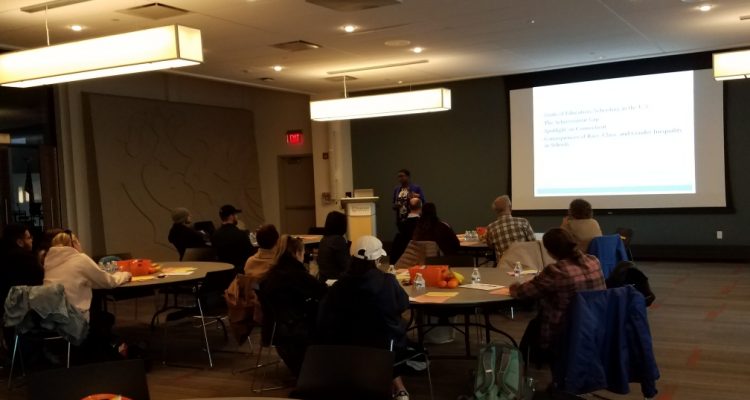“Not like the brazen giant of Greek fame,
With conquering limbs….from land to land;
Here at our…gates shall stand
A mighty woman with a torch…and her name
Mother of Exiles…Give me your tired, your poor,
Your huddled masses yearning to breathe free,
…Send them…to me,
I lift my lamp beside the golden door!”
– Emma Lazarus, “New Colossus,” 1883
We’ve all heard of the American Dream. It’s the idea that every U.S. citizen has an equal opportunity to achieve success through hard work. This idea is immortalized forever by Emma Lazarus’ poem engraved on the Statue of Liberty, our “mighty woman with a torch.” The idea of the American Dream is hard-wired into our society. But does it exist?
Dr. Rachelle Brunn-Bevel, Ph.D., assistant professor of sociology and anthropology who teaches several courses that count toward the U.S. Diversity core requirement, discussed the idea of the meritocracy-driven American dream at her lecture for the U.S. Diversity Fall Lecture Series.
Senior Kate Gangemi explained her interest in attending the event, “I’m here because I’m interested in race, class and gender in the context of education. I think it’s important to understand these issues as a future educator.” Gangemi is an English major with educational studies and black studies minors.
Sophomore Danielle Mineri said that she was, “interested in learning how educational inequality affects people and their futures.”
In her discussion, Brunn-Bevel discussed how school is often thought of as “the great equalizer,” which is a quote from Theodore Roosevelt. She also talked about the latent functions of education: that children are fed while at school, that school is thought of as a safe place for children to be while parents are at work and that children socialize with others while at school. At school, children learn to become good workers – to be on time to class, to get along with peers, to understand critical thinking – so they can later become wage earners.
When schools “reproduce the systems of inequality,” privileging some students while placing others at a disadvantage, this “hidden curriculum serves to reproduce the class hierarchy,” Brunn-Bevel said.
Brunn-Bevel gave three mini-discussion breaks for the audience to divide up into small groups and discuss questions raised in her presentation, such as “What role does education play in a child’s life?” In one small group, students discussed the importance of pre-kindergarten, or preschool, and Brunn-Bevel elaborated on this importance in her lecture. If children have not had early language development and socialization, they may already be behind before they have even started kindergarten, placing a stopgap in the idea of social mobility and the American dream.
Students also learned how children from lower income households, children who are learning English as a second language, and children with disabilities are all at a disadvantage when it comes to education. Brunn-Bevel showed students CTmirror.org, which grades Connecticut schools, displaying how segregation by race and class exists in towns right next to each other, such as Fairfield and Bridgeport. There is a significantly larger class size in lower-income towns- on average, 25 students per class. There is also a larger number of college counselors in towns like Bridgeport, which has one college counselor for every 400 students, than in towns like Westport, which has one college counselor for every 200 students.
When asked how people can help change the unequal education system, Brunn-Bevel said that it is important to vote for school board representatives and for government officials who want to evenly distribute resources for education across a state instead of an uneven distribution based on the income levels of each individual town. Education informs the way people view the world for the rest of their lives. As Brunn-Bevel said, “as long as we see gaps into who gets degrees, there is still work to be done.”


Leave a Reply